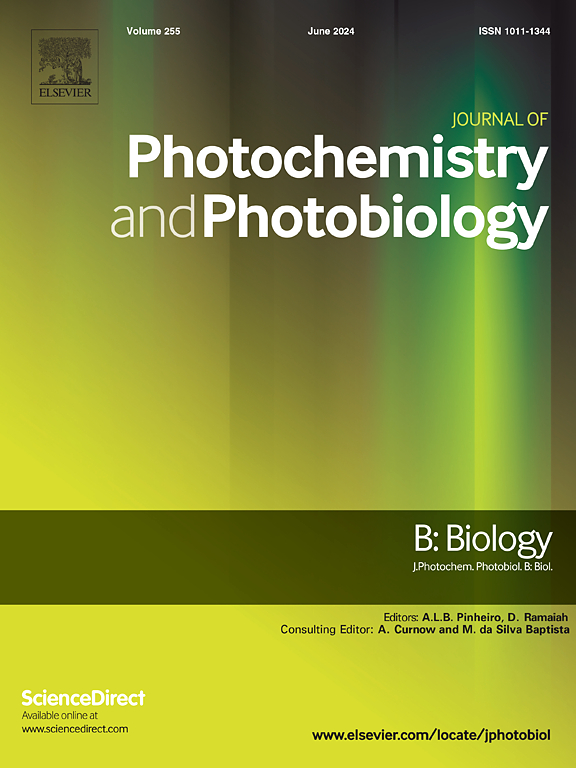Lysosome-localization and tumor-targeting of novel photosensitizers enhance the ablation of cancer
IF 3.9
2区 生物学
Q2 BIOCHEMISTRY & MOLECULAR BIOLOGY
Journal of photochemistry and photobiology. B, Biology
Pub Date : 2024-10-28
DOI:10.1016/j.jphotobiol.2024.113045
引用次数: 0
Abstract
Lysosomes are promising therapeutic targets for cancer therapy due to their essential function and increased vulnerability in cancer cells. Herein, we report a new category of cationic photosensitizers (compounds 1–3) containing a quaternary ammonium group. These photosensitizers exhibited selective uptake on cancer cells (about three times compared to the normal cells), lysosome-specific localization (Pearson's coefficients greater than 0.85), remarkable phototoxicity (IC50 are in the range of dozens of nM), and at the same time, favorable biosafety. Mechanically, these tumor-targeting photosensitizers function as light-controlled “bombs”, inducing lysosomal membrane permeabilization (LMP), ultimately resulting in apoptosis of cancer cells. In vivo, compound 1 (a representative of these novel photosensitizers) accumulated predominantly in and visualized tumors implanted on mice. Upon exposure to near-infrared light irradiation (50 J/cm2), the compound effectively ablated the tumor at a low dose of 2 mg/kg. Our results demonstrate a novel class of photosensitizers showing potential for integrated cancer diagnosis and photodynamic treatment.

新型光敏剂的溶酶体定位和肿瘤靶向性增强了癌症消融效果。
溶酶体具有重要功能,但在癌细胞中的脆弱性增加,因此是很有希望的癌症治疗靶点。在此,我们报告了一类含有季铵基团的新型阳离子光敏剂(化合物 1-3)。这些光敏剂表现出对癌细胞的选择性吸收(约为正常细胞的三倍)、溶酶体特异性定位(皮尔逊系数大于 0.85)、显著的光毒性(IC50 在数十 nM 的范围内),同时具有良好的生物安全性。从机理上讲,这些肿瘤靶向光敏剂具有光控 "炸弹 "的功能,可诱导溶酶体膜通透(LMP),最终导致癌细胞凋亡。在体内,化合物 1(这些新型光敏剂的代表)主要积聚在植入小鼠体内的肿瘤中,并使肿瘤可视化。经近红外光照射(50 J/cm2)后,该化合物在 2 mg/kg 的低剂量下就能有效消融肿瘤。我们的研究结果表明,一类新型光敏剂具有综合癌症诊断和光动力治疗的潜力。
本文章由计算机程序翻译,如有差异,请以英文原文为准。
求助全文
约1分钟内获得全文
求助全文
来源期刊
CiteScore
12.10
自引率
1.90%
发文量
161
审稿时长
37 days
期刊介绍:
The Journal of Photochemistry and Photobiology B: Biology provides a forum for the publication of papers relating to the various aspects of photobiology, as well as a means for communication in this multidisciplinary field.
The scope includes:
- Bioluminescence
- Chronobiology
- DNA repair
- Environmental photobiology
- Nanotechnology in photobiology
- Photocarcinogenesis
- Photochemistry of biomolecules
- Photodynamic therapy
- Photomedicine
- Photomorphogenesis
- Photomovement
- Photoreception
- Photosensitization
- Photosynthesis
- Phototechnology
- Spectroscopy of biological systems
- UV and visible radiation effects and vision.

 求助内容:
求助内容: 应助结果提醒方式:
应助结果提醒方式:


